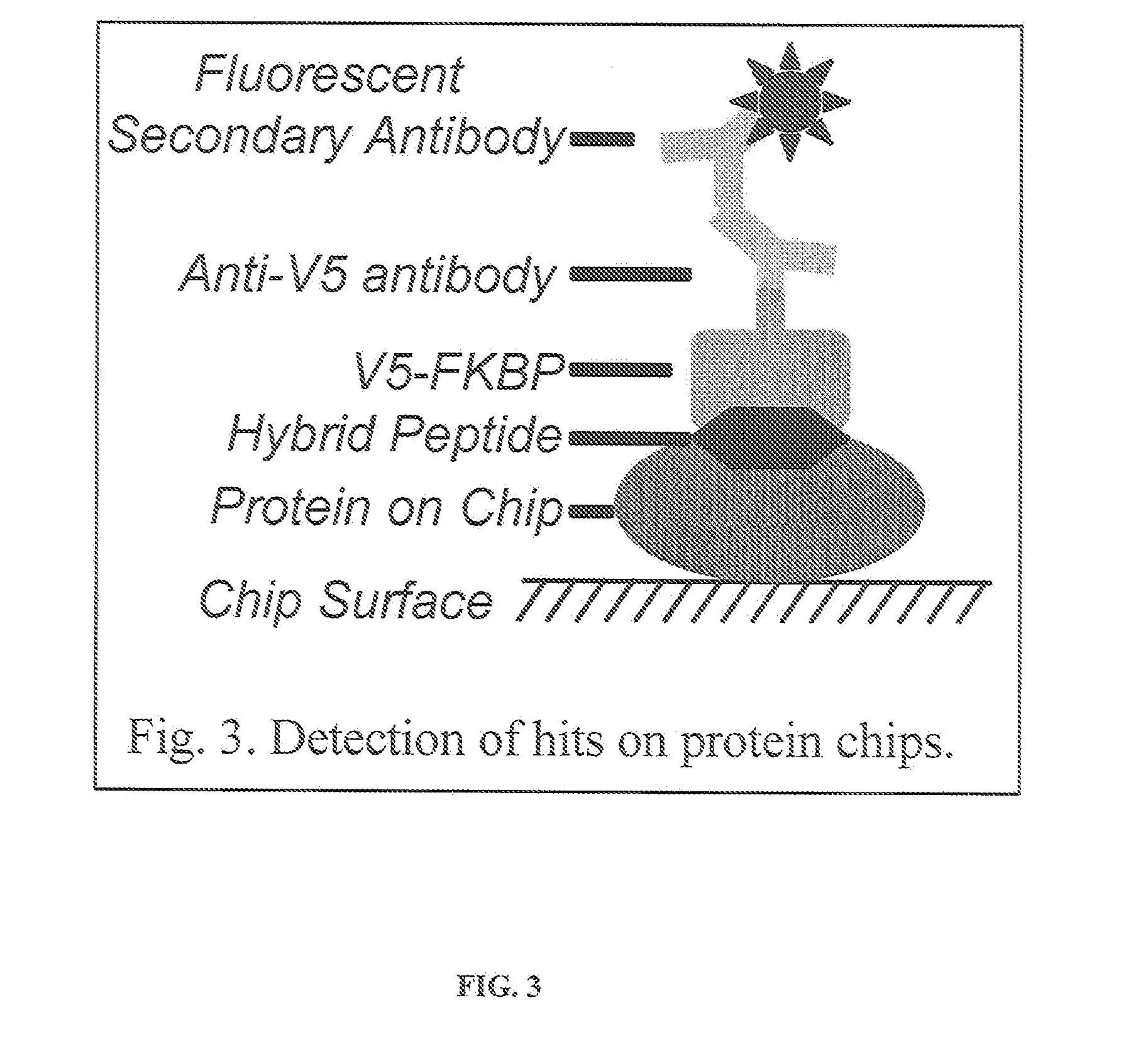Hybrid Cyclic Libraries and Screens Thereof
- Summary
- Abstract
- Description
- Claims
- Application Information
AI Technical Summary
Benefits of technology
Problems solved by technology
Method used
Image
Examples
example 1
Synthesis of 2 in Scheme 2
[0381]To a solution of rapamycin (999 mg, 1.09 mmol) and anhydrous triethylamine (Et3N) (0.6 mL, 4.45 mmol) in anhydrous dichloromethane (CH2Cl2) (3 mL) is added tert-butyldimethylsilyl triflate (TBSOTf) (0.85 mL, 3.79 mmol). The solution is stirred for 1 hour at room temperature and quenched with water. The resulting mixture is diluted with ethyl acetate (EtOAc) (120 mL), washed with saturated sodium bicarbonate (NaHCO3) and brine, and dried and concentrated in vacuo. The crude residue is subjected to silica gel column chromatography (Hexanes / EtOAc, 8:1) to afford 2 (1.37 g, 100*) as a yellow solid: 1H NMR (400 MHz, CDCl3): δ 6.39-5.82 (m, 4H), 5.52-4.91 (m, 4H), 4.45-3.98 (m, 2H), 3.83 (d, 7-4.0 Hz, 1H), 3.40 (s, 3H), 3.27 (s, 3H). 3.10 (s. 3H), 2.89-2.83 (m, 1H), 2.66-2.40 (m, 3H), 2.23-2.19 (m, 3H), 1.70 (s, 3H), 0.17-0 (m, 18H); 13C NMR (100 MHz, CDCl3): δ 210.3, 206.6, 197.9, 169.5, 167.0, 139.3, 139.0, 136.6, 132.0, 130.8, 127.4, 126.7, 126.4, 101.7,...
example 2
Synthesis of 3 in Scheme 2
[0382]To a solution the silyl derivative 2 (1.20 g, 0.95 mmol) in CH2Cl2 (15 mL) at −68° C. is bubbled ozone (03) until the blue color persisted. 35% hydrogen peroxide (H202) (15 mL) is added and the stirring is continued for another 14 hours at room temperature. The solution is diluted with EtOAc (120 mL), washed with brine, dried and concentrated to afford an oil that is purified using silica gel chromatography (Hexanes / EtOAc, 4:1, then CH2Cl2-MeOH, 20:1) to provide an epimeric mixture (710 mg) as a white solid. The epimeric mixture from the ozonolysis reaction stated above (210 mg, 0.26 mmol) is dissolved in anhydrous THF (2 mL), and added to a freshly prepared Wittig reagent at 0° C., which in turn was prepared from CH3PPh3Br (560 mg, 1.57 mmol) and tert-BuOK (140 mg, 1.25 mmol) in anhydrous THF (5 mL). After stirring for 10 minutes, the reaction mixture is quenched with 5% HCl. The resulting mixture is diluted with EtOAc (60 mL), washed with brine, dri...
example 3
Synthesis of 4 in Scheme 2
[0383]To a mixture of trifluoroacetic acid (CF3C02H) (0.8 mL) and H20 (0.2 mL) at 0° C. is added olefin 3 (32 mg, 0.040 mmol). After stirring for 2 hours, the mixture is concentrated in vacuo and purified by silica gel chromatography (CH2Cl2-MeOH—AcOH. 20:1:0.2) to provide 4 (22 mg, 96%) as a white solid: 1H NMR (400 MHz, CDCl3): 5.82-5.68 (m, 1H), 5.27-4.90 (m. 4H), 4.45-4.32 (m, 1H), 4.02-3.85 (m, 1H), 3.40 (s, 3H). 2.99-2.94 (m, 1H), 2.65-2.51 (m, 2H): 13C NMR (100 MHz, CDCl3): δ 197.8, 194.8, 175.1, 175.0, 171.0, 170.0, 169.8, 169.3, 169.3, 167.6, 166.8, 165.7, 135.1, 134.8, 134.3, 117.4, 117.1, 116.7, 99.3, 98.5, 97.7, 84.4, 75.7, 75.2, 75.0, 73.9, 70.2, 70.1, 56.5, 56.4, 51.5, 44.5, 43.1, 41.5, 41.4, 40.2, 39.1, 38.9, 35.1, 35.0, 34.4, 34.3, 34.1, 33.4, 33.2, 31.3, 30.8, 30.6, 29.7, 27.5, 27.1, 26.6, 26.4, 26.3, 25.0, 24.6, 24.4, 21.1, 20.9, 20.8, 16.7, 16.1, 15.9, 15.7, 15.3, 15.1, 15.0; HR-ESIMS calcd for C30H47010NNa |M+Na]* 604.3098. found 604.309...
PUM
 Login to View More
Login to View More Abstract
Description
Claims
Application Information
 Login to View More
Login to View More - R&D
- Intellectual Property
- Life Sciences
- Materials
- Tech Scout
- Unparalleled Data Quality
- Higher Quality Content
- 60% Fewer Hallucinations
Browse by: Latest US Patents, China's latest patents, Technical Efficacy Thesaurus, Application Domain, Technology Topic, Popular Technical Reports.
© 2025 PatSnap. All rights reserved.Legal|Privacy policy|Modern Slavery Act Transparency Statement|Sitemap|About US| Contact US: help@patsnap.com



